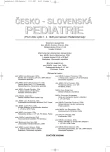-
Medical journals
- Career
Early Diagnostics of Asperger Syndrome and Specific Aspects
Authors: J. Schmidtová 1; M. Hrdlička 1,2
Authors‘ workplace: Dětská psychiatrická klinika UK 2. LF a FN Motol, Praha přednosta prof. MUDr. M. Hrdlička, CSc. 1; Univerzita Karlova, 1. lékařská fakulta, Praha děkan prof. MUDr. T. Zima, DrSc., MBA 2
Published in: Čes-slov Pediat 2008; 63 (1): 9-18.
Category: Original Papers
Overview
Asperger syndrome belongs to very serious developmental disorders. The development of an individual with the Asperger syndrome compared to normal development is obvious from early infancy and maladaptive and abnormal behavior occurs during the whole following life of the individual. The diagnostics of Asperger syndrome at the preschool age appears to be easier for occurrence of specific autistic symptoms, whereas manifestations of Asperger syndrome at the school age are not so typical and may be associated with other diagnostic categories especially in cases, where clinical manifestation had not been sought in taking history of the child at the preschool age. The undiagnosed or erroneous diagnosis may result in serious consequences including the effect on decreased quality of life in the affected individual.
The communication also includes two case histories demonstrating early and belated diagnostics of the disorder.Key words:
Asperger syndrome (AS), early diagnostics of AS, maladaptive behavior of individuals with AS, symptomatology of AS, specific interests of AS
Sources
1. Asperger H. Die autistischen Psychopathen im Kindesalter. Archiv für Psychiatrie und Nervenkrankheiten 1944;117 : 76–136.
2. American Psychiatric Association. Diagnostic and Statistic Manual of Mental Disorders, 1980. 3rd ed. (DMS –III). Washington, D.C: American Psychiatric Association.
3. Mezinárodní klasifikace nemocí, 10. revize. Duševní poruchy a poruchy chování. Popisy klinických příznaků a diagnostická vodítka (překlad z anglického originálu). Praha: Psychiatrické centrum, 1992.
4. Hrdlička M, Komárek V, et al. Dětský autismus. 1. vyd. Praha: Portál, 2004.
5. Rutter M. Autistic children: infancy to adulthood. Seminars in Psychiatry 1977;2 : 435–450.
6. Kolvin I. Studies in childhood psychoses. I. Diagnostic criteria and classification. Br. J. Psychiatry 1971;118 : 381–384.
7. Rutter M, Hersov R. Child Psychiatry. Modern Approaches. Oxford: Blackwell, 1977.
8. Klin A., Volkmar FR, Sparrow SS. Asperger Syndrome. New York: Guilford, 2000 : 25–72, 231–254.
9. Wing L. Asperger’syndrome: a clinical account. Psychol. Med. 1981 : 115–129.
10. Eisenmajer R, Prior M, Leekman S, et al. Comparison of clinical symptoms in autism and Asperger’s syndrome. J. Am. Acad. Child. Adolesc. Psychiatry 1996;35 : 1523–1531.
11. Lovaas O. Behavioral treatment and normal educational and intellectual functioning in young autistic childern. J. Consult. Clin. Psychol. 1987;55 : 3–9.
12. Wendy L, Stone PD, Edward L, et al. Early recognition of autism. Parental reports vs clinical observation. Arch. Pediatr. Adolesc. Med. 1994;148 : 174–179. Překlad: Časné rozpoznání autismu, rodičovská versus klinická pozorování. JAMA–CS 1994;2(11): 836–840.
13. Hoyson M, Jamieson B, Strain PS. Individualizing group instruction of normally developing and autistic-like children, the LEAP curriculum model. J. Div. Early Child. 1984 : 157–172.
14. Rogers SJ, Lewis H. An effective day treatment model for youg children with pervasive developmental disorders. J. Am. Acad. Child. Adolesc. Psychiatry 1989;28 : 207–214.
15. Woolley H, Stein A, Forrest GC, Baum JD. Imparting the diagnosis of life threatening illness in children. BMJ 1989;298 : 1623–1626.
16. Cottrell DJ, Summers K. Communicationg an evolutionary diagnosis of disability to parents. Child Care, Health and Development 1990;16 : 211–218.
17. Quine L, Pahl J. First diagnosis of severe handicap: a study of parent’s reactions. Dev. Med. Child. Neurol. 1987;29 : 232–242.
18. Stallard P, Lenton S. How satisfied are parents of pre-school children who have special needs with the services they have received? A consumer survey. Child Care, Health and Development 1992;18 : 197–205.
19. Left PT Walizer EH. The uncommon wisdom of patent at the moment of diagnosis. Family Systeme Medicine 1992;21 : 147–167.
20. Howlin P. Children with Autism and Asperger Syndrome – A Guide for Practitioners and Carers. 1st ed. London: Winley, 1998 : 52–105.
21. Attwood T. Asperger Syndrome – A Guide for Parents and Professional. 1st ed. London: Jessica Kingsley Publishers, 1998.
22. Propper L, Hrdlička M, Thorová K. Vysoce funkční autismus a Aspergerův syndrom: problematika koncepce a diferenciální diagnostiky. Prakt. Lék. 1999;79 : 610–614.
23. Charman T, Baird G. Practitioner review: Diagnosis of autism spectrum disorder in 2–3-years-old children. J. Child. Psychol. Psychiatry 2002 : 289–305.
24. Strain PS, Hoyson M, Jamiseson B. Normally developing preschoolers as intervention agents for autistic-like children. J. Div. Early Child. 1985 : 105–115.
25. Gillberg C, Ehlers S, Schaumann H, et al. Autism under age 3 years: a clinical study of 28 cases referred for autistic symptoms in infanty. J. Child. Psychol. Psychiatry 1990;31 : 921–934.
26. Howlin P. Autismus u dospívajících a dospělých. 1. vyd. Praha: Portál, 2005.
Labels
Neonatology Paediatrics General practitioner for children and adolescents
Article was published inCzech-Slovak Pediatrics

2008 Issue 1-
All articles in this issue
- Transcutaneous Bilirubinometry in Preterm Newborns
- Early Diagnostics of Asperger Syndrome and Specific Aspects
- Aspirated Foreign Bodies in Children
- Juvenile Myelomonocytic Leukemia Associated with Neurofibromatosis and Complicated by Hemophagocytic Syndrome
- Acute Renal Failure in Newborn Period – Initial Symptom of Inborn Error of Metabolism of Purines
- Neural Tube Defects – Current Opinion on Etiopathogenesis and Prevention Potencial of Folic Acid
- PROTEIN HYDROLYSATES IN PREVENTION AND THERAPY
- Czech-Slovak Pediatrics
- Journal archive
- Current issue
- Online only
- About the journal
Most read in this issue- Aspirated Foreign Bodies in Children
- Early Diagnostics of Asperger Syndrome and Specific Aspects
- Neural Tube Defects – Current Opinion on Etiopathogenesis and Prevention Potencial of Folic Acid
- Transcutaneous Bilirubinometry in Preterm Newborns
Login#ADS_BOTTOM_SCRIPTS#Forgotten passwordEnter the email address that you registered with. We will send you instructions on how to set a new password.
- Career

